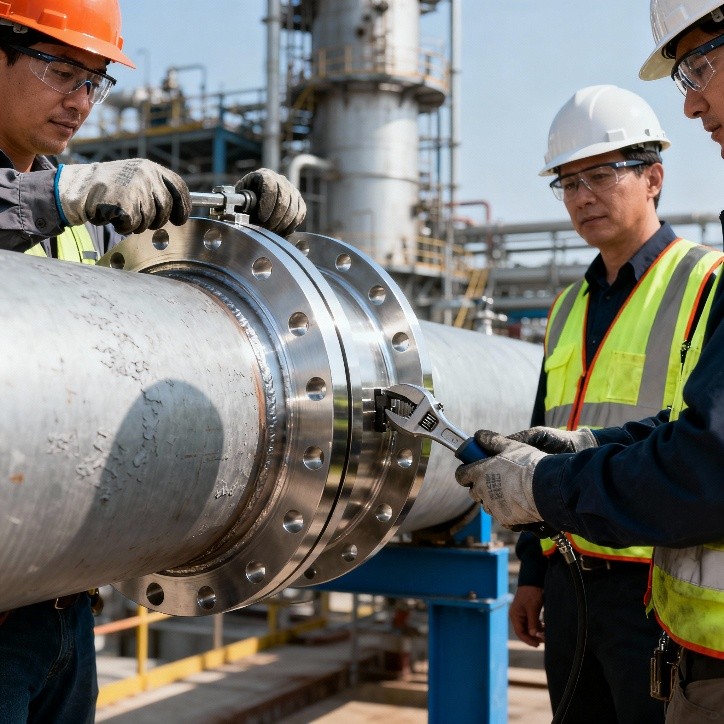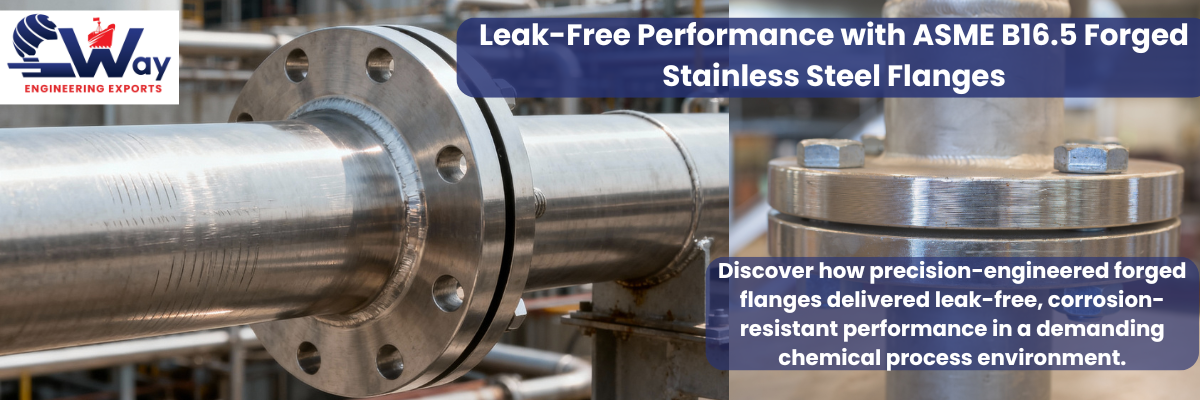A Case Study on Reliability, Material Selection, and Flange Design Precision
When Pipeline Integrity Meets Corrosive Reality
Every engineer knows that one of the biggest enemies of a chemical processing plant is leakage. When pipelines carry highly corrosive media like acids, solvents, or caustic solutions, even a minor leak can lead to safety risks, production losses, and environmental violations.
This is exactly what a leading chemical manufacturer in Texas was facing. Despite using stainless steel slip-on flanges, persistent leaks were developing along critical pipeline joints. After multiple attempts with gasket replacements and re-tightening, the problem persisted — until a complete system analysis led to a game-changing solution: ASME B16.5 Forged Stainless Steel Flanges.
This case study explores how switching to ASME B16.5-compliant forged flanges solved the leakage issues once and for all, and how correct flange design, material grade, and installation practices made all the difference.
Project Overview
Client: Leading U.S. Chemical Processing Plant
Location: USA
Application: Corrosive chemical transfer line (Sulfuric Acid + Caustic Soda)
Pipeline Size: 4” to 10”
Operating Pressure: 16–25 bar
Temperature Range: Up to 180°C
Material Previously Used: Cast stainless steel slip-on flanges (ASTM A351 CF8)
Problem: Recurring leakage at flange joints after every maintenance cycle
Solution Implemented: ASME B16.5 Forged Stainless Steel Weld Neck Flanges (ASTM A182 F316L)
Problem Analysis: Why Leaks Occurred in the Existing System
The maintenance team initially suspected poor gasket performance. But a detailed inspection revealed that the root cause lay in the flange design and material integrity.
1. Slip-on flanges under thermal cycling:
The chemical plant’s pipelines underwent frequent temperature fluctuations. Slip-on flanges, though economical, tend to allow micro-movements between the pipe and the hub, leading to gasket stress relaxation and eventual leaks.
2. Casting defects in flanges:
The existing flanges were made from cast stainless steel. Microscopic porosity and shrinkage cavities in castings compromised their sealing surfaces, especially when exposed to corrosive acids.
3. Improper gasket face finish:
The flange’s raised face had an inconsistent surface finish — some were too smooth, preventing proper gasket grip, while others were rough, causing uneven sealing.
4. Insufficient bolt torque:
Without precise torque control, bolt preload was inconsistent, allowing differential pressure across joints to escape through the gasket interface.
It became clear that the solution required more than a simple gasket replacement — it required redesigning the flange joints to meet both ASME B16.5 standards and the plant’s corrosive environment.
Engineering Solution: The Shift to ASME B16.5 Forged Stainless Steel Flanges
After a full root cause study, the engineering team recommended replacing the existing flanges with ASME B16.5 Forged Stainless Steel Weld Neck Flanges (F316L material).
Why forged? Because forging eliminates internal porosity and produces a denser, more homogeneous microstructure — critical for resisting corrosion and pressure fluctuations.

Key Design Features Implemented:
| Feature | Description | Engineering Advantage |
|---|---|---|
| Flange Type | Weld Neck Flange | Provides high structural integrity; ideal for high-pressure and temperature systems. |
| Material Grade | ASTM A182 F316L | Superior resistance to chlorides, acids, and oxidizing agents. |
| Standard | ASME B16.5 | Ensured dimensional accuracy, bolt hole alignment, and face finish consistency. |
| Face Type | Raised Face (125–250 AARH finish) | Optimized gasket grip for better sealing. |
| Bolting Material | ASTM A193 B8M Class 2 | Matched thermal expansion with stainless steel, reducing stress differentials. |
| Gasket Type | Spiral Wound SS316 with Graphite Filler | Excellent resilience under thermal cycling. |
The system was designed with accurate torque values (calculated using ASME PCC-1 guidelines), ensuring even gasket compression without over-tightening.
Why ASME B16.5 Standards Matter
ASME B16.5 defines the dimensions, pressure ratings, tolerances, materials, and testing requirements for pipe flanges from ½” to 24”. Compliance ensures global interchangeability, reliability, and safety in piping systems.
In this project, adherence to ASME B16.5 was key because it:
• Guaranteed precise bolt hole alignment — critical for consistent sealing pressure.
• Defined raised face height and surface roughness — ensuring gasket compatibility.
• Allowed the use of pressure class ratings (150–600) suitable for the plant’s operating pressure.
• Mandated hydrostatic testing, ensuring zero leakage before commissioning.
By upgrading to forged flanges built to ASME B16.5, the plant aligned its system with international best practices, making future maintenance and expansion easier and safer.
Installation and Commissioning
The installation was carried out by the plant team during a planned maintenance shutdown. Each flange joint was assembled under the supervision of a certified piping engineer.
Steps included:
1. Surface inspection — verifying flatness and roughness per ASME standards.
2. Gasket alignment — ensuring concentric placement to prevent uneven compression.
3. Lubrication and torqueing — bolts tightened in a star pattern using calibrated torque wrenches.
4. Hydrostatic testing — system pressurized to 1.5x operating pressure for 30 minutes; no leaks detected.
After startup, the system was monitored continuously for 60 days. The result? Zero leakage. Even after thermal cycling and pressure surges, the flange joints held firm.

Results and Performance Improvement
| Parameter | Before (Slip-On Cast Flanges) | After (Forged Weld Neck Flanges) |
|---|---|---|
| Leak Incidents (per year) | 7–8 | 0 |
| Maintenance Downtime | 5 days | < 1 day |
| Gasket Replacement Cost | $8,000/year | Negligible |
| Overall Pipeline Efficiency | 84% | 98% |
| Safety Risk Rating | Medium | Low |
Within six months, the plant reported complete elimination of leakage issues, a 20% reduction in maintenance costs, and improved process stability.
Technical Takeaways
1. Forging matters.
Forged stainless steel offers far better integrity than cast components, especially in high-pressure chemical environments.
2. Weld Neck Flanges outperform Slip-On types
in systems with thermal expansion and vibration.
3. Proper face finish (125–250 AARH)
is critical for optimal gasket performance.
4. Torque control and bolt material compatibility
ensure lasting joint integrity.
5. ASME B16.5 compliance
guarantees standardization and reliable performance across global installations.
Our customer Reviews
Joel Martin- Maintenance Supervisor, Chemical Plant (Texas, USA):
“We contacted C-Way Engineering Exports after facing continuous corrosion and leakage problems in our chemical plant flanges. Their team was extremely professional and technically strong. All discussions happened through video calls. They carefully understood our process requirements, supply ASTM A105 and A182 materials and manufactured the flanges exactly as per our specifications. The products arrived on time, perfectly packed, and the quality was outstanding. Since installation, we haven’t faced a single corrosion or leakage issue. We truly appreciate their commitment and technical support.”
M. Saad- Project Engineer, Contractor:
“We were impressed by the dimensional precision and surface quality of the forged flanges provided by C-Way. Delivery was smooth, and the sealing performance exceeded expectations. This is how flanges should be made. Thank you C-Way Engineering team for helping us to send all the flanges on time”
Applications Beyond This Case
The success of this upgrade has inspired similar projects in:
• Acid handling plants
• Desalination facilities
• Refineries and petrochemical units
• Pharmaceutical process lines
• Water treatment and wastewater systems
Everywhere corrosion meets pressure, forged stainless steel flanges are proving to be the gold standard.
Leak-Free Performance Starts with the Right Flange
In corrosive chemical environments, even the smallest leak can lead to major consequences. This case proves that engineering precision, not shortcuts, defines reliability.
By choosing ASME B16.5 Forged Stainless Steel Flanges, the plant not only solved a persistent leakage issue but also set a new benchmark for safety and performance in chemical processing systems.
When flange design, material selection, and installation align — leak-free pipelines become the new normal.
Looking to upgrade your pipeline systems to meet ASME, DIN, or EN standards?
At C-Way Engineering Exports, we manufacture and supply a complete range of industrial flanges, valves, and fittings — all engineered for reliability, precision, and long-term performance.
Whether it’s a high-pressure oil pipeline or a corrosive chemical plant, our forged stainless steel and alloy steel flanges are designed to perform where others fail.
Contact us today to discuss your application or request a technical datasheet.
Your next leak-free solution starts with C-Way Engineering Exports.






